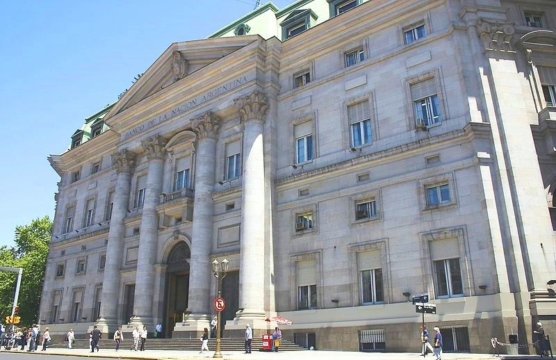
Will Default Dampen China-Argentina Ties?
The Fernández administration’s refusal to comply with a US court order to pay holdout hedge funds has once again landed Argentina in default.
Brazil was the star of Chinese Premier Li Keqiang’s four-country tour of Latin America in late May. Over the course of his stay, China’s head of government announced tens of billions in headline-grabbing deals.
Li and Brazilian President Dilma Rousseff also signed a 2015-2021 joint action plan, inked 35 cooperative documents, and discussed Olympics-related deals and trans-oceanic railway development.
As Chinese leaders are wont to do in overseas tours, Li focused on: cooperation (in clean energy, iron ore, agriculture, oil & gas, and shipbuilding) and mutual benefit (in this case, by means of” industrial capacity investment” in Brazilian rail, mining, and power industries).
What really resonates during these high-level visits, however, is China’s remarkable and growing economic footprint in the region. China is already a critical partner for Brazil and other LAC nations, but Li’s message was one of more. More investment, trade, finance, and cooperation – albeit in industries in where China is already fairly active.
Chinese companies have already made considerable inroads in the industries – mining, agriculture, electricity, clean energy, oil & gas, and rail/ships – cited by Li during his Brazil visit.
China is a top market for Brazilian iron ore and soy exports. China’s major grains trader, COFCO, is seeking greater involvement in various phases of agricultural production in Brazil and other countries. The company’s 2014 acquisition of Dutch firm Nidera, which owns assets throughout Latin America, supports this objective.
Chinese electricity transmission giant State Grid made quick inroads into Brazil’s transmission market after founding a Brazilian subsidiary in 2009. State Grid Brazil’s outspoken Chairman, Cai Hongxian, indicated in 2014 that it’s “only a matter of time” before his company expands operations in Brazil beyond electricity transmission.
Chinese firms have been eyeing Brazil’s clean energy industries for years, though discouraged at times by Brazil’s often challenging investment environment. Chinese electric car manufacturer, BYD, chose the city of Campinas (in the Sao Paulo region of Brazil) for its first South American manufacturing facility. Slated to open in 2015, the factory will manufacture and assemble the world’s only long-range pure electric transit bus in South America, as well as related battery packs.
A leader in green technology at home, BYD Founder and Chairman, Mr. Wang Chuanfu, is also seeking to build solar panels and energy storage systems in Brazil.
As indicated in a 2014 Dialogue report, Chinese companies Yingli Solar and AstroEnergy are already active in Brazil’s solar industry, having initiated projects in Caerá and Rio, respectively. Chinese wind energy companies, Sinovel and Goldwind, are looking for space in the country’s booming wind industry.
China’s national oil companies are on a steady course to grow their presence in Brazil’s upstream. Chinese oil companies have acquired stakes in Repsol Brazil, Statoil’s Peregrino field, and Galp Energia Brazil in recent years. Together, CNOOC and CNPC maintain a twenty percent stake in the Libra pre-salt consortium. And Li announced yet another multi-billion dollar loan for Petrobras during his May visit.
Shipping has been a source of contention between China and Brazil. China for two years prevented Vale’s Valemax ships from docking in Chinese ports, likely at the behest of Chinese shipping giant COSCO. Vale and COSCO played nicely in advance of Li’s visit, however, by firming up agreements to transport iron ore to China.
If history is any indication, it’s unlikely that all of the deals and agreements announced during Li’s visit will come to fruition.
That said, China has been gearing up for bigger investment in Brazil and other LAC countries for over a year now.
The “1+3+6 cooperation framework,” announced by Xi Jinping last July, promotes enhanced economic engagement in “6” sectors (energy & resources, infrastructure, agriculture, manufacturing, S&T, and information technology).
And then there’s Xi’s promise of $250 billion in investment stock in LAC and $500 billion in total trade in the next ten years.
Geopolitical considerations are also stimulating investment in the region. The Chinese state has more to gain by developing trans-regional transport infrastructure (think: Peru-Brazil railway, Venezuela-Colombia pipeline, Colombia dry canal, Brazil-Peru roadway, Nicaragua canal, etc.) than friendships and financial returns. Secure transport routes are a priority as China seeks to achieve domestic food and energy security.
Will Brazil and other LAC nations see more Chinese investment in the coming years? Com certeza!
State-affiliated and other Chinese investors are looking to diversify their portfolios and Chinese firms of all sizes are seeking new markets for their goods and services. Despite slowing growth, LAC is an attractive market for many a Chinese investor.
The challenge for Latin American nations, as many have argued, is attracting much–needed investment, while ensuring that projects are demand-driven and promoting of long-term and sustainable economic growth.
The Fernández administration’s refusal to comply with a US court order to pay holdout hedge funds has once again landed Argentina in default.
Despite turnover among China’s leaders, relations with Latin America are likely to progress much as they have over the past few years.
In May of this year, Brazil offered 289 non-pre-sal conventional oil and gas blocks to international bidders.